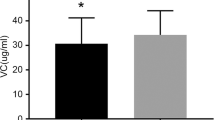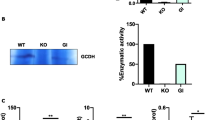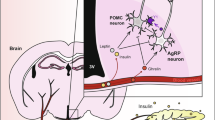Abstract
IN a recent publication1 it was shown that gold thioglucose produces lesions in the ventromedial hypothalamic area of injected mice. It had previously been shown2 that gold thiomalate, although similar to gold thioglucose with respect to toxicity, gold content and molecular weight, does not cause obesity; its injection does not lead to hypothalamic lesions1. To study further the specificity of gold thioglucose in causing ventromedial hypothalamic lesions and hyperphagia the action of other gold thio compounds was examined, in particular a compound where the gold thio moiety is linked to a radical very similar to glucose, namely, gold thiosorbitol (supplied through the kindness of Abbott and Co.), and compounds where the gold thio moiety is linked to metabolites other than glucose: besides gold thiomalate, gold thiocaproic acid and gold thioglycerol were available (also supplied by Abbott and Co.). The effects of gold thioglycoanilide and gold sodium thiosulphate were also examined. The main dose of each compound used in these experiments was calculated to provide as much gold as is contained in the dose of gold thioglucose found most effective to yield obese mice. (In a series of 800 Swiss mice treated with gold thioglucose 1 mgm./gm. body-weight was found to induce obesity in 60 per cent of surviving mice and varying degrees of ventromedial hypothalamic damage in all animals examined.) For each compound in addition to the main dose a number of multiples and fractions of this standard dose were used.
This is a preview of subscription content, access via your institution
Access options
Subscribe to this journal
Receive 51 print issues and online access
$199.00 per year
only $3.90 per issue
Buy this article
- Purchase on SpringerLink
- Instant access to full article PDF
Prices may be subject to local taxes which are calculated during checkout
Similar content being viewed by others
References
Marshall, N. B., Barrnett, R. J., and Mayer, J. Proc. Soc. Exp. Biol. Med., 90, 240 (1955).
Marshall, N. B., and Mayer, J., Amer. J. Physiol., 178, 271 (1954).
Anliker, J., and Mayer, J., C.R. Acad. Sci., Paris, 241, 285 (1956).
Mayer, J., Ann. N.Y. Acad. Sci., 63, 15 (1955); Nutrition Abst. and Rev., 25, 597, 871 (1955).
Author information
Authors and Affiliations
Rights and permissions
About this article
Cite this article
MAYER, J., MARSHALL, N. Specificity of Gold Thioglucose for Ventromedial Hypothalamic Lesions and Hyperphagia. Nature 178, 1399–1400 (1956). https://doi.org/10.1038/1781399a0
Issue date:
DOI: https://doi.org/10.1038/1781399a0
This article is cited by
-
High-fat feeding promotes obesity via insulin receptor/PI3K-dependent inhibition of SF-1 VMH neurons
Nature Neuroscience (2011)
-
Pathogenesis of gastric mucosal damage induced by intraperitoneal administration of gold thioglucose in rats
Gastroenterologia Japonica (1989)
-
Reserpine prevents goldthioglucose hypothalamic lesions in mice
Experientia (1981)
-
Insulin acting as a modulator of feeding through the hypothalamus
Diabetologia (1981)
-
The biological chemistry of gold
Gold Bulletin (1976)



